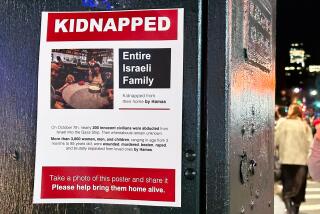Poster for Guantanamo documentary is censored
- Share via
The Motion Picture Assn. of America has censored a poster advertising a film about the U.S. detention facility at Guantanamo Bay, Cuba.
The image that ran afoul of the MPAA is tame by the standards set by the amateur photographers of Abu Ghraib. It shows a man hanging by his handcuffed wrists, with a burlap sack over his head and a blindfold tied around the hood. It appeared in advertisements for the new film “The Road to Guantanamo,” a documentary with some reenacted scenes that follows the fate of three British men imprisoned at Guantanamo for more than two years. Eventually they were released, with no charges ever filed against them.
The distributors of the film, directed by Michael Winterbottom and Mat Whitecross, submitted the poster to the MPAA, which must approve publicity materials for the films it rates, on April 24. It was rejected the next day.
“The reason given was that the burlap bag over the guy’s head was depicting torture, which wasn’t appropriate for children to see,” said Howard Cohen, co-president of Roadside Attractions, which is distributing the film in North America. The film will open June 23, advertised by another poster, approved by the MPAA, which shows only a pair of shackled hands and arms.
MPAA spokesperson Gayle Osterberg said its standards for print advertising are particularly sensitive.
“If it’s a poster that’s hanging in a theater, anyone who walks into that theater, regardless of what movie they’ve come to see, will be exposed to it,” Osterberg said. Although she wouldn’t comment on the particular reason for the poster’s rejection, and while MPAA guidelines for what is acceptable in advertising aren’t made public, she did list some of the things that are not allowed: “depictions of violence, blood, people in jeopardy, drugs, nudity, profanity, people in frightening situations, disturbing or frightening scenes.”
Cohen says he understands why the MPAA exercises control over advertising materials -- he’s a father himself. But that doesn’t diminish his frustration with the decision.
“This is a film with a serious purpose, and this is the subject of the film itself, and the marketing materials were appropriate to the subject,” he said. And, he added, horror flicks and slasher movies are often advertised with images far more suggestive of graphic violence. He cited a poster for the film “Hard Candy,” about Internet predators, which showed a small child framed by a bear trap.
His argument is supported by advertisements for last year’s horror flick “Hostel,” which left little doubt about the blood, gore and decapitation that audiences could expect.
“When you look at standards for horror movies, their standards are not consistent,” Cohen said. “What is implied in horror movie posters is way worse than what’s in this movie.”
Although Osterberg says that torture is not specifically cited in the guidelines governing print materials, the proscription against violence, blood and disturbing scenes “would probably encompass” it. Thus, the MPAA’s decision puts it at odds with the United States government, which has repeatedly defended techniques, including hooding prisoners, as not legally torture.
In a 2003 Department of Defense report, hooding was given a green light, as not inconsistent with the United States’ obligations under international conventions or U.S. law. The report also approved prolonged standing, though stipulated that it “should never make the detainee exhausted to the point of weakness or collapse.” And that it not be “enforced by physical restraints.”
This means the MPAA required a change in the image that removed something not deemed torture (hooding) and focused instead on the shackled hands and extended arms that clearly depicts someone forced to stand (or worse, hang) under restraint to the point of collapse, which might well be torture.
Kirby Dick, director of “This Film Is Not Yet Rated,” a new film devoted to the MPAA and its ratings system, said that’s not the only irony in the MPAA’s decision.
He compares the MPAA’s secrecy to the secrecy that has governed so much of what has happened at the prison in Guantanamo and other U.S. facilities where suspects in the war on terror have been held.
“It’s also interesting that the image is of someone whose vision is being blocked -- and that’s the image that they’re blocking,” Dick said. “When you get into censorship, the irony never stops.”
More to Read
Only good movies
Get the Indie Focus newsletter, Mark Olsen's weekly guide to the world of cinema.
You may occasionally receive promotional content from the Los Angeles Times.







